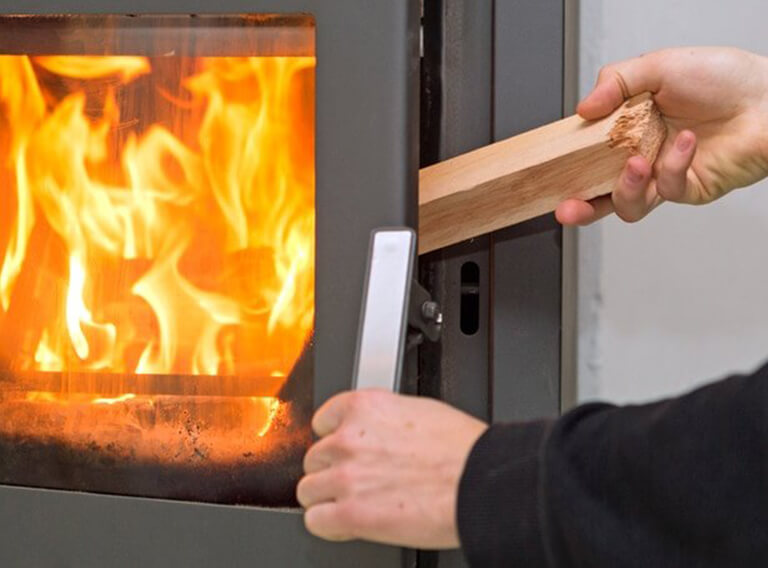Emissions from stoves – the burning problem
Fireplaces are popular because they spread cozy warmth. At the same time, however, they are one of the largest sources of particulate matter. Should they still be promoted in the future?
By Philipp Wundersee, WDR
“It’s a great warmth,” says Uta Hartmann from Bergisch Gladbach. “With the stove in the living room, we really enjoy the cold days. It’s different from having heated air.” The 49-year-old adds two logs and briskly closes the door to her stove. “With gas prices right now, we’re also running the fireplace as a real alternative to keep the home warm.” She is not alone in this preference. More than eleven million wood-burning stoves can be found in Germany’s living rooms, providing plenty of coziness with their warmth and dancing flames. “I heat here in an environmentally friendly way and with a renewable raw material,” says Hartmann.
Federal Environment Agency warns of fine dust pollution
Wood has the image of an environmentally friendly energy source. But the Federal Environment Agency (UBA) sees things differently. “Fireplaces, which are becoming increasingly popular, are a considerable pollutant to air quality,” according to the Federal Environmental Agency. “In Germany, particulate emissions from wood combustion far exceed tailpipe emissions from trucks and cars,” says the UBA.
The particulate matter from wood combustion is no less harmful than the particulate matter from road traffic, he said. Analyses by the University of Rostock show: Heating with wood produces fine particles that can penetrate the lungs and trigger serious diseases. Especially in inversion weather conditions, when the upper air layers are warmer than the lower ones, as well as in valley and basin locations, there can be considerable pollution of the air we breathe, according to UBA.
Forests are destroyed
Heating with wood is also viewed critically by the nature conservation organization Robin Wood. “Burning wood increases the demand for the valuable raw material and thus the pressure of use on forests that are already weakened and overexploited by climate change and air pollutants,” says Ute Bertrand of Robin Wood. “Forests with high biodiversity in the Romanian Carpathians, on the Baltic or in Scandinavia are irretrievably destroyed for wood burning.”
Burning wood on an industrial scale is not carbon-neutral, he said, because trees take many decades to recapture the carbon dioxide released by burning the wood biomass. “Wood is a valuable raw material. Harvesting it and burning it is the worst possible solution,” says Bertrand. “Rather, wood should be used sparingly and for long-lasting products.”
The German Energy Wood and Pellet Association disagrees. “Pellet and wood-burning stoves are generally used to fire individual rooms in order to save on energy prices,” says Martin Bentele, the association’s executive director. “Properly used, modern pellet stoves heated with the right fuel are not a problem emission-wise.” Figures from the Central Guild Association of Chimney Sweeps show that the number of traditional wood-burning stoves is stagnating and the number of modern, automatically operated wood-fired central heating systems is increasing.
State sponsored system
So far, certain forms of heating with wood are still subsidized by the state because this is considered more climate-friendly than heating with fossil fuels. This is to be over if the Federal Environment Agency has its way: there should be no more new investments in wood-fired heating systems. This also refers to wood pellet heaters, in which compressed sawdust and wood waste are burned. They have a reputation as a climate-friendly way besides gas and oil heating and are promoted.
However, the climate protection activists from Robin Wood also view this funding critically. “Promoting wood heating systems hurts the environment and climate protection,” Bertrand says. “Financial incentives to burn wood should be stopped. Public funds are urgently needed elsewhere to advance a climate-friendly energy transition, for example through energy-efficient building renovation or to promote heat pump technology.” For wood pellet heating systems, the German Federal Office of Economics and Export Control offers homeowners a subsidy of up to 45 percent.
Operating error with consequences
According to the Federal Environment Agency, pellet heating systems are not without problems in terms of particulate matter. But the output is usually lower than the classic stove, because the pellets are standardized and their water content is low. Also, operating errors are excluded.
According to the Federal Environment Agency, stoves are significantly more problematic. For in the fireplace come logs. If the logs, which Uta Hartmann also stores and dries in her garage, are not dry enough, they produce a particularly large amount of pollutants. Operator error causes emissions to rise. If you add fuel too late and the flame has already gone out, you will release large amounts of pollutants because of the smoldering logs.
Therefore, the lowest-emission approach to stoves would be: buy firewood from the region, burn dry wood, store firewood properly, light stoves properly, do not burn newsprint because it can release pollutants from the printer’s ink. It is also important to have an adequate air supply. Nevertheless, the Federal Environment Agency advises using stoves as rarely as possible. “The environment and the climate are helped most when the stove stays off,” says the Federal Environment Agency.
Deutschlandfunk reported on this topic on February 10, 2022 at 11:43 am.
02/27/2022 https://www.tagesschau.de/wirtschaft/technologie/kaminofen-101.html
